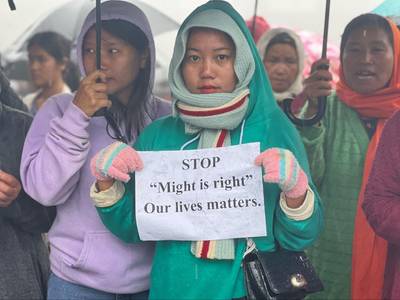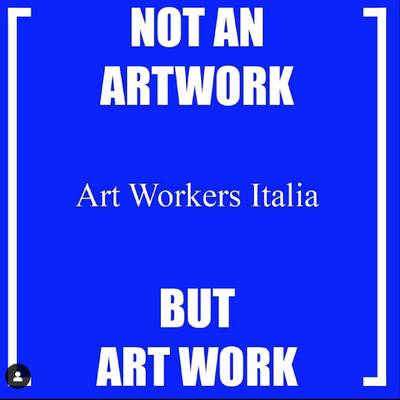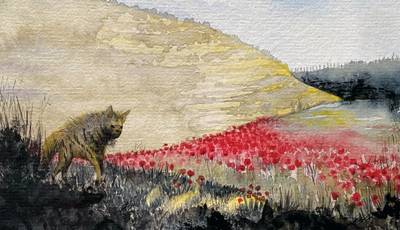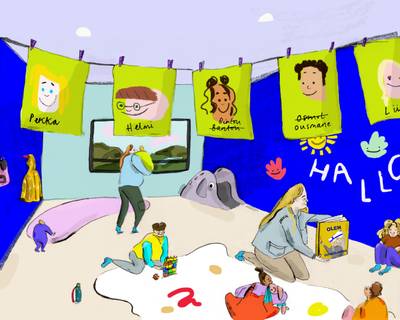

Minjee Hwang Kim, What do I call you?, 2021, paper cutout
Minjee Hwang Kim is a visual artist from Seoul, South Korea and based in Helsinki. In her works she explores time, space, and belonging through the theme of a journey. Kim’s works have been shown in multiple solo and group shows in Helsinki, Seoul, New York, and online platforms. Kim holds an MFA from the Academy of Fine Arts Helsinki and BFA from Korea National University of Arts.
What do I call you?
I’ve been losing sleep. Maybe it is the abrupt change in light here in the north. Perhaps it is the new medication I recently started. But I know it’s neither of them that’s causing my insomnia. I am going through a breakup. But wait one moment: can I call it a breakup? We have never agreed on what label to put on us, so I am not sure what I am breaking.
I was listening to Taeyeon’s song, “What Do I Call You,” when I suddenly started crying. In the lyrics, Taeyeon wonders how she should address her ex-boyfriend when he is no longer her honey and daisy. Who is he when he is an outsider to her world? I started questioning my situation: Who are you? I feel like he never existed in my life, as I can’t give us in both past and present a name.
I am the type of person who needs names and distinction in characteristics to comprehend whatever is happening in my world. I often blame it on growing up as a middle child in an immigrant family: the constant and urgent need to discern and explain what is mine and not. I am Minjee. I am Korean. I am a woman. Where are you from? What is your pronoun? What do I call you?
Labeling was fairly simple when I was small. The world comprised dichotomous terms of ‘men/women’, ‘Korean/non-Korean’, ‘east/west’… But as my world expands with time, the categories get more diverse and complex that sometimes, I lose track.
Ever since the “breakup”, I’ve been revisiting the memories we have created together as I needed to decide for myself if he was my boyfriend or my friend. And as I classify the memories into two categories of relationship or friendship, I again wonder: Why couldn’t it have been just you and me? If such a thing is achievable, I won’t be going through this pain.
Although, can we ever be without names?
Before, everyone was either a man or a woman depending on which genitals you were born with. Now, by using gender neutral vocabulary, I know that gender is a spectrum and a social construct, not your assigned biology. There was also a time when the world was populated by either White people or people of color when skin tone automatically meant beige. Now, I recognize the array of bodies by giving each of them back their names. You can’t unsee once you start seeing.
CASES:
* A, B, and C are not specific individuals, but mash-ups of different people
- A is a Third Culture Kid, a term for people raised in a culture different from their birth culture. I avoid specifying A’s nationality or cultural background when I describe A to others, as I don’t know how A identifies themselves. However, there are moments when I have to define A in one way or another. I halt: Should I say A’s birth country or raised country?
- B is a transwoman. I seldom go on sharing that with others. But as I use she/her as B’s pronoun, some questions, “Wait, B is a woman?” I again hesitate if I should mention that B is transfeminine or not. I only have secondhand experience with transsexuality, and I am concerned as a ciswoman about distinguishing women and transwomen.
- C is a person of color born and raised in Finland. They identify themselves as Finn. I once stereotyped a ‘Nordic body type’ when C and I were discussing Finnish fashion design, and by specifying a Nordic body as a white body, I excluded C from what C takes as their identity.
Labels and names make a difference in our perception. I have discovered more names and labels in the past three years than in my entire life before that. Before, everyone was either a man or a woman depending on which genitals you were born with. Now, by using gender neutral vocabulary, I know that gender is a spectrum and a social construct, not your assigned biology. There was also a time when the world was populated by either White people or people of color, when skin tone automatically meant beige. Now, I recognize the array of bodies by giving each of them back their names. You can’t unsee once you start seeing.
The new categories help me treat and respect others in a way they want to be treated and respected, as well as contemplating how I want to take place in society-as an Asian, as a woman, as a feminist and anti-racist. However, what do you envision when I say ‘A is Ecuadorian’’ and ‘A is Spaniard‘? What about ‘woman’ and ‘transwoman’? ‘Finnish’ and ‘Chinese Finnish’? When we label someone-by nationality, race, gender, religion, i.e.,– are we sure we are making clear of that individual? Or are we deciding how to see that person before actually seeing that person?
My friend Tien
My friend Tien works in customer service at a Vietnamese company. Most of her clients are North Americans using the company’s service online. Tien uses a different name, Emma, at work.
A couple of months ago, I was getting a refund for a broken home appliance from a German online retailer. Communication with the CS team wasn’t going smoothly, and I complained to Tien about how Jennifer seemed not to understand English. Tien simply laughed at my naivete while pointing out how spoiled I am expecting everyone to know English.
“Minjee, there is no Jennifer. They are Asians using a white name. The companies outsource their customer service to Southeast Asia to cut labor costs.”
Tien further explained that the customers’ response notably differs when they think they are talking to a non-Westerner, which is the reason for opting for an alternative name, not a company policy. If she makes one slight error as Tien, there will be insults flying around, Karen demanding to talk to the manager. But it is all fine when she is Emma. We are all humans. We all make mistakes.
When you are an immigrant kid living in middle-class North American suburbs, there is nothing more you might want than to be White. And an alternative name was a way to insert myself into the White world of sleepovers and skateboarding. Precisely which name I used isn’t crucial (it was Hannah), but why did a 10-year-old child feel the pressure to rename, and possibly reinvent herself?
I can still recall the exact moment of the reinvention. It was the year 2001 when my family moved from Riverside to Pasadena, California. My father was enrolling me at a new school and when the administrator asked for my name, I talked loudly over my father trying to spell out my Korean name for the bored-looking woman behind the desk: “I am Hannah, H-A-N-N-A-H Kim.”
“Hannah” baffled my parents. In their opinion, my Korean name (Minjee, pronounced like Min-chii) is not that difficult for Americans to pronounce compared to my sister’s name, which she proudly kept. They also didn’t understand why I would choose such a generic name when I can go for more prominent ones (such as?). My parents never stopped me from becoming Hannah. They had no power to interfere. They at the same time refused to call me anything other than Minjee.
Since Hannah, people no longer mistook me for my sister or other Asian kids with an Asian name. Boys confessed their crushes on me. Girls invited me to their parties. I never had to repeat myself, even though the way I blend my S- and TH- sounds when I speak English is the same even to this day because I never bothered to do my speech class homework.
If Minjee is a Korean kid, probably good at math (I’m not) and plays the violin (I don’t), Hannah is just another girl next door who is best friends with Kristin and Melinda. She speaks English; she runs for student council; she plays Benjamin Franklin in drama class; she is a tetherball champion. Hannah is visible and invisible at the same time by the power of assimilation.
Emma and Hannah, Hannah and Emma, they are after all the same person. And Jennifer working at customer service is the same too, whoever this person actually might be. But what about Tien and Minjee?
Tien and I bond over our Asianness in Finland, sharing our love for rice and fangirling over the same K-Pop celebrities. We link arm to arm walking around the city, drinking bubble tea as we would do in our home countries, laughing, holding our heads high.
At the same time, Tien is Vietnamese, and I am Korean. Tien majored in business and I in painting. Assuming that we will be more or less alike as we are measured into the same “Asian” group fails to recognize Minjee and Tien as individual human beings. Is our Asianness enough to bond us together, to have us belong in the same category, despite our personal, ethnic, and regional differences between Southeast Asia and Northeast Asia? Because we are both Asians in Finland, does this automatically mean we share the same values and opinions? Are Tien and Minjee the same people? When are labels enough?
You can’t find someone who doesn’t want to be found.
In Isabelle Allende’s novel The House of the Spirits, Clara del Valle has paranormal powers to communicate with spirits and foresee the future. When her husband Esteban Trueba evicts his sister Férula from the house, Clara tries to use her power to find Férula. However, Clara is warned to stop searching as Férula does not want to be seen. Then Clara remembers the psychic Mora Sisters’ comment from a long time ago: ‘You can’t find someone who doesn’t want to be found.’ It strangely comforts Clara to know that people can protect themselves by willpower.
I became Hannah because I didn’t want people to find Minjee and all the connotations that came along with it. I just wanted to be treated as a girl-next-door. However, I no longer use the name Hannah. And over time, it turned into a joke for those who knew me back then. Hannah represents a whitewashed Asian, a banana yellow on the outside and white on the inside, ashamed of her cultural heritage, offended at every Korean related question directed towards her. However, just because I am now comfortable using my Korean name does not mean I am any less in hiding than Hannah.
Like many artists based in Finland, my clock ticks along to grant and exhibition application deadlines more than to the sun and the moon. Every week or two I will sit down to serve a spectacle for the anonymous panel, hoping I can entertain them enough to decide in my favor. The spectacles often include my racial identity, personal trauma, and family saga, the stories I would prefer to keep between myself and my secret Tumblr. When I was writing my first few applications, I was extremely cautious – tweaking small details about myself so that I wouldn’t be exposed bare. But as my hard drive’s GRANT folder accumulates both successful and rejected applications, I go numb about neatly presenting the intimate content in WHAT, WHERE, WHEN, and WHY.
The questions I answer in a grant application are not vastly different from those I answered 20 years ago as an immigrant child. They want to know where I am from and how I recognize myself in their society. However, what they want and need to hear has changed. We are no longer in the Californian suburbs, where I wore Whiteness as armor. This is the 2021 Helsinki Art scene where diversity is currency, thus I shall prove how wonderfully alien I am. I plate up Minjee seasoned with a dash of violence, leaving out any positive or affirming experiences that might come with my racial identity.
In artwork and writing, I now bring my Korean heritage to the fore, from painting self-portraits to actively incorporating Korean narratives, contrary to acting like they have nothing to do with me. And during the past three years I spent in Helsinki, my practice started to carry some sense of honesty from and to myself. I am more content with parts and past of me that I long wished didn’t exist. However, I don’t particularly see myself as’ ‘matured,’ or ‘changed,’ just because I am more accepting of those parts of myself. What changed is not who I am, but who is looking at my art, and what I don’t want those to find in me.
When Elham, Vidha, and I sat down over cappuccinos to discuss ideas for the essay, I pitched my usual topics of migration, generational conflict, racism, and patriarchy. I was dealing with Migri and my residence permit at the time of the meeting, so bureaucracy was also on the agenda. It is not a lie that the aforementioned topics interest and excite me, but it is not the entirety of either me or my art practice. And even if no one would explicitly say it, I know that this is what the Western institutions expect to hear from me as a diversity role.
After listening to my pitch and sipping some coffee, Elham and Vidha directly started out by saying that I don’t need to feel any pressure to write about negative experiences associated with my identity to have a space in NO NIIN and that it is common for a person of color to feel the unsaid obligation to be an advocate for the entire community, which is not expected of those who belong in the more privileged or majority group. I can write about anything and be just a person, who lives for gossip and seldom reads any news outside the K-Pop entertainment section, let alone be a spokesperson for the whole Asian diaspora. It is OK. There is room for me too.
Then why am I still writing about my Asianness?
On March 16, 2021, Robert Aaron Long killed eight people (Delaina Ashley Yaun; Paul Andre Michels; Xiaojie Tan; Daoyou Feng; Hyun Jung Grant; Suncha Kim; Soon Chung Park; Yong Ae Yue), six of whom were Asian women, and wounded one other person in a series of mass shootings in Atlanta, Georgia, USA. The police say sex addiction motivated the suspect, and he has shot the Asian women to get rid of the source of his temptation. The police have not charged Long with a hate crime as part of the investigation.
While Georgia Officer Captain Jay Baker said Long was having a “bad day,” on the day of the mass shooting, what shocked me more was that neither Korean ambassador in Washington DC nor the Atlanta consul general attended any funerals, shooting sites, or commemoration ceremonies, despite four of them being Korean American or Korean citizens. The Atlanta consul general however attended another Korean American funeral, which was hosted four days after the shooting. He responded to the questions about his selective appearance, “the deceased was a pillar of the Atlanta Korean American community.”
Both the police and the Korean bureaucrats will never admit it, but we all know what labels they have put on the victims. Asian. Virus. Me so horny. Massage parlor. Whores. Fillers, not pillars, of the society.
Maybe this is why I chose to write about Asianness.
The Child Who Cried Wolf
I am always confused about the moral of this story. Is the story trying to say ‘don’t lie because people will lose trust in you’ or ‘keep lying until your lie becomes the truth?’ I envision the child in ecstasy rather than shock when the wolf finally appears.
It has been drilled into me for a long time that bad things happen because I am not good. In the 21st century, anti-Asian racism or patriarchy doesn’t exist, and if a racial or misogynic incident happens, it is not because I am Asian or a woman. I’ve been desensitized to think structural oppression is my fault or plain bad luck.
My family moved back to Korea in 2003 and I no longer had reasons to be Hannah. And I wonder, what would have happened if I continued living in the US? Would I have eventually lost Minjee to a place no one can find her?
The denial of structural oppression stretches into the model minority myth for many Asians in the West. To be a model minority is to be grateful, complicit, and needed but never too important. The assumption that Asians in the West are all hardworking overachievers who have made it to the highest level of educational, financial, and social success sets a false illusion that systemic discrimination against Asians don’t exist.
Also, as Asians aspire to belong in the White-supremacist society, we voluntarily or not often hold up the system that disadvantages other people of color for their race. We have the chance to tell the “success stories” of how we diligently work from dawn to dusk to send the kids to medical school. But it is also a monolith, putting vastly diverse ethnicities and culture of the largest continent into a single category. Model minority myth marginalizes again the minorities within the minority, impeding us from having important equity conversations and solidarity.
What Coronavirus at least did was shed off our almost-White skin, and make clear that anti-Asian racism and discrimination does exist and it has always existed. We are not delusional or distracting away from the “real issue” by saying something is racist. If Asians have so far remained silent to prioritize the comfort of the dominant group, it is now time to come to racial reckoning and speaking up.
My family moved back to Korea in 2003 and I no longer had reasons to be Hannah. And I wonder, what would have happened if I continued living in the US? Would I have eventually lost Minjee to a place no one can find her?







